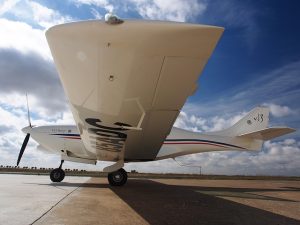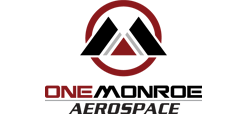
When inspecting the wings of an airplane, you may notice they have hinge-like flaps on the trailing edge. Known as ailerons, they play an important role in modern aviation. Ailerons allow pilots to “roll” airplanes, thereby banking the aircraft to the left or right. Below are five facts about ailerons and how they work.
#1) The Word “Aileron” Means “Little Wing.”
The word “Aileron” comes from the French language, meaning “little wing.” It’s a fitting definition given their design. Ailerons are small, and like wings, they generate lift during flight. Air will move under and over an airplane’s wings and ailerons. Assuming the ailerons are raised and flush with the rest of the wings, they will generate lift that helps the airplane overcome gravity.
#2) Move in Opposite Directions
Ailerons move in opposite directions. When one aileron is deflected down, the aileron on the opposite wing is deflected upward. This opposing movement is what banks the airplane. The downward-deflected aileron creates drag on that side of the airplane. With the aileron raised on the opposite wing, the airplane will bank.
#3) Inboard vs Outboard Ailerons
While some airplanes only have two ailerons — one on each wing — others have four ailerons, including two inboard ailerons and two outboard ailerons. Both types of ailerons are found on the trailing edge of an airplane’s wings. The difference is that inboard ailerons are located closer to the fuselage, whereas outboard ailerons are found farther away from the fuselage and near the wingtips.
#4) Move in Response to Yoke or Stick Input
Ailerons move in response to yoke or control stick input. To bank the airplane in a particular direction, pilots will move the yoke or stick in that direction. In doing so, the airplane’s ailerons will move. One of the ailerons will move down, and the aileron on the opposite wing will move up.
#5) Not the Only Method for Controlling Roll
Ailerons aren’t the only to control an airplane’s roll. There are other control surfaces that can control roll, such as rudders and elevators. Rudders and elevators, though, are found on the tail assembly, whereas ailerons are found on the wings. Furthermore, engaging the rudders and elevators requires more work from pilots than simply moving the yoke or stick.
In Conclusion
Ailerons are essential control surfaces that make it possible for pilots to roll and bank airplanes with precision. Their opposite, coordinated movement provides the aerodynamic forces needed for smooth and responsive directional changes during flight. Whether positioned inboard or outboard, ailerons work in direct response to pilot input, allowing for intuitive maneuvering.



